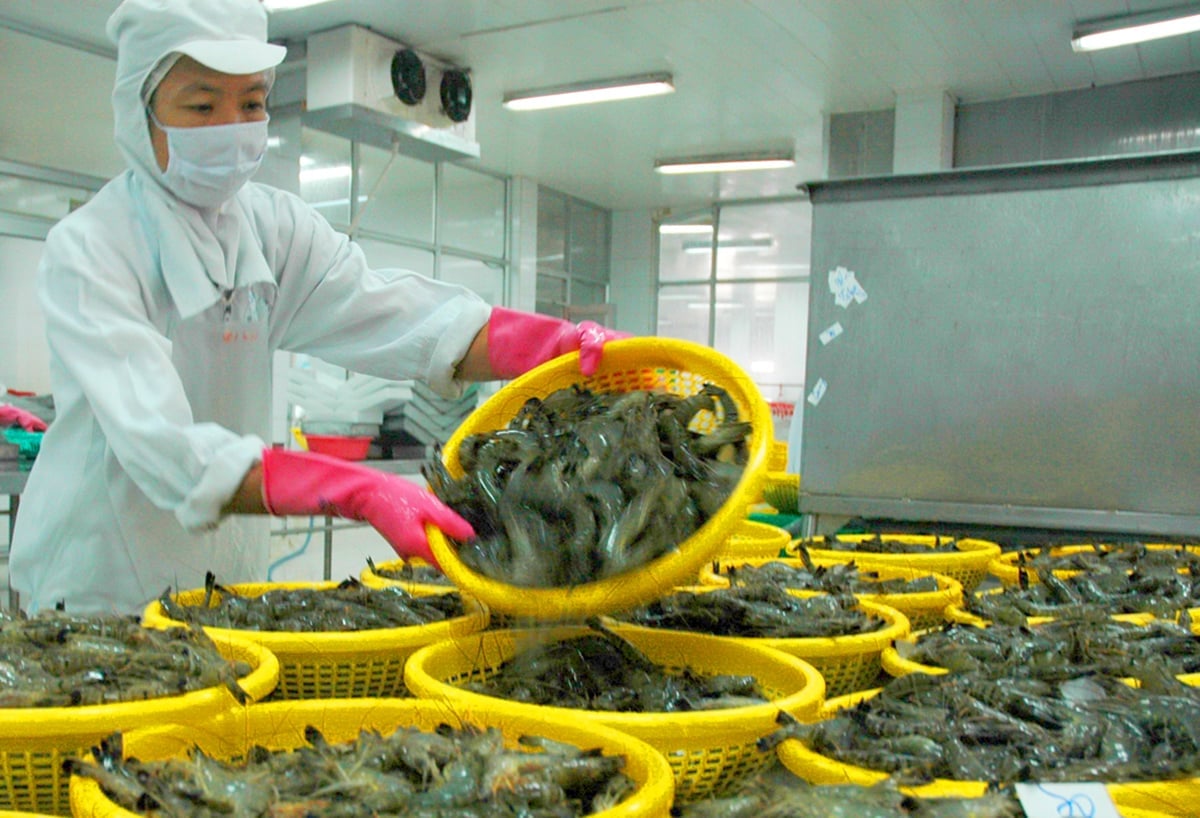November 28, 2025 | 01:10 GMT +7
November 28, 2025 | 01:10 GMT +7
Hotline: 0913.378.918
November 28, 2025 | 01:10 GMT +7
Hotline: 0913.378.918
According to the Ministry of Agriculture and Environment, in the first half of this year, despite the global economic downturn, Vietnam’s agro-forestry-fishery (AFF) exports managed to accelerate and maintain growth momentum. In the first seven months, total export value was estimated at USD 39.24 billion, up 13.6% year-on-year. Of this, agricultural products brought in USD 21.49 billion (up 17%), livestock products USD 339.2 million (up 22.1%), seafood USD 6.06 billion (up 13.8%), and forestry products USD 10.38 billion (up 8.6%).
In the first seven months, eight out of 11 key AFF export items recorded growth, with notable increases seen in coffee, shrimp, pepper, and livestock products.

Shrimp exports posted strong growth in the first seven months. Photo: Le Hoang Vu.
Coffee recorded exceptional growth, with export turnover reaching USD 5.9 billion, up 63.4% year-on-year. The sharp increase in coffee export value was driven by high average export prices (over USD 5,600 per ton, up 53.5%), improved quality of Vietnam’s Robusta coffee, and reduced global coffee supply due to climate change and the El Niño phenomenon.
Shrimp exports reached USD 2.5 billion in the first seven months, up 23.2%. Lobster exports saw particularly strong growth (up 225.2%), especially in Asian markets such as China (nearly USD 400 million, up 224.5%), ASEAN (nearly USD 3 million, up 152%), Taiwan (up over 700%), and the UAE (up over 370%). Lobster exports to the United States also surged by more than 1,400%.
Pepper exports also posted high growth, totaling USD 981 million (up 28.5%). The strongest increase was in the U.S. market (up 28.4%), which accounted for 26% of total exports.
Livestock products earned USD 338 million in export turnover in the first seven months, up 21.9%. Although the export value remains modest, the sector saw positive changes in Q2 thanks to growth in meat and by-products, which brought in over USD 100 million (up 26.5%).
Products maintaining growth included wood and wood products (USD 9.6 billion, up 7.3%), cashew nuts (USD 2.7 billion, up 15.7%), rubber (USD 1.5 billion, up 11.8%), tra fish (USD 1.1 billion, up 8.1%), and cassava and cassava products (USD 746 million, up 1.4%).
In the first seven months of 2025, while agro-forestry-fishery exports to China grew modestly and declined in the ASEAN region, export value continued to hold steady in the U.S. market and posted robust growth in regions such as the EU, Japan, the Middle East, and Africa.
This reflects that in Q2, industry associations and businesses acted proactively and swiftly, striving to maintain and expand exports of key products to all markets, including processed livestock products, which still have modest export value but strong growth potential.

Rice exports through seaports in Ho Chi Minh City. Photo: Thanh Son.
At the same time, businesses accelerated the fulfillment of export orders for competitive products such as wood and wood products, seafood, coffee, pepper, and cashew nuts in traditional markets like the U.S., EU, and Japan, while redirecting exports to potential markets such as Africa and the Middle East for certain product groups facing challenges in traditional markets, such as rice, fruits, and vegetables.
Amid global market uncertainties, enterprises have proactively expedited the execution of signed export contracts to the U.S. during the period before reciprocal tariffs take effect, while actively seeking and shifting to other export markets. They have also strengthened potential traditional markets such as China and the EU. These efforts have contributed to strong export growth results in the first seven months of 2025.
On June 27, 2025, the Ministry of Agriculture and Environment issued Decision No. 2396/QĐ-BNNMT on the plan to boost agro-forestry-fishery exports in 2025, aiming for total export turnover of USD 65 billion. The targets include: coffee USD 7.5 billion; rubber USD 3.3 billion; tea USD 270 million; rice USD 5.7 billion; fruits and vegetables USD 7.6 billion; cashew nuts USD 4.5 billion; pepper USD 1.35 billion; cassava and cassava products USD 1.3 billion; livestock products USD 550 million; seafood USD 10.5 billion; and wood and wood products USD 18.5 billion.
With agro-forestry-fishery exports in the first seven months of 2025 estimated at USD 39.2 billion, the sector will need to achieve over USD 25 billion in the final five months to meet or exceed the annual target. However, the remaining months are forecast to present multiple challenges to exports, including the U.S. reciprocal tariffs set to take effect on August 1, 2025.
In response, the Ministry of Agriculture and Environment has set a general requirement to sustain exports, maintain and stabilize traditional markets, and tap into and shift toward potential markets. All opportunities should be seized to boost exports in the remaining five months of 2025, maximizing export value, seeking new markets, or negotiating tariff reductions. Product groups facing difficulties in the U.S. market should be actively redirected to other, more promising markets.
The overarching solution to promote agro-forestry-fishery exports in the rest of the year is to continue leveraging the state’s key role in accompanying, guiding, and supporting enterprises and producers through mechanisms and policies aimed at maintaining and safeguarding production, sustaining exports, and preserving the competitiveness of agricultural products amid global trade fluctuations. Priority should be given to credit policies, exchange rate measures, reducing logistics costs, cutting administrative procedures, and lowering fees and charges, thereby creating favorable conditions and sharing the burden with businesses and farmers.
Provide timely, rapid updates on market developments and clarify new regulations (tariffs, definitions of transshipment goods, etc.) so associations, businesses, and producers can grasp the situation and promptly take appropriate actions.
Persist in negotiating tariff reductions for product lines that the United States cannot produce and must import (coffee, pepper, cashew).
Continue to maintain exports to traditional markets while adding suitable product lines and some product groups that can increase export value in potential markets, such as seafood to China, Japan, Korea and ASEAN; wood and wood products to China, Japan and the EU; fresh herbs and fruits to Korea, Japan and ASEAN; and coffee to China, Japan and ASEAN.
In the past seven months, three product groups recorded a decline in growth — fruits and vegetables, rice, and tea. Fruit and vegetable exports reached only USD 3.8 billion, down 1.1%, mainly because most high-value fruits such as durian, dragon fruit, and mango saw declines in the Chinese market.
Rice exports in the same period totaled USD 2.8 billion, down 16.3%, primarily due to a sharp drop in export prices caused by high stockpiles in major importing countries such as the Philippines and Indonesia, as well as intense competition from other major exporters like India and Thailand.
Translated by Phuong Linh

(VAN) On November 27, in the meeting with Minister Tran Duc Thang, Mayor Yin Yong shared Beijing’s experience to improve environment and air quality.

(VAN) After 30 years, both sides identified strategic areas of cooperation: sustainable production, increasing coffee value and training for farmers.
/2025/11/27/4910-4-164708_294.jpg)
(VAN) On the afternoon of November 27 in Beijing, Minister of Agriculture and Environment Tran Duc Thang held a working session with several major Chinese enterprises operating in the agriculture and environment sector.

(VAN) The Department of Animal Health issued a provisional guideline requesting local authorities to increase surveillance, collect samples for testing, and conduct epidemiological investigations according to the established procedure.

(VAN) The United Nations recommends that Vietnam utilize data and artificial intelligence to enhance early disaster warnings and reduce GDP losses by 3.2% in the context of climate change.

(VAN) On the morning of November 27 in Beijing, Minister Tran Duc Thang and the Deputy Commissioner General of the General Administration of Customs of China signed a protocol on fresh jackfruit exports.

(VAN) As floodwaters recede, a vast network of irrigation works across eastern Gia Lai is emerging in a state of severe disrepair, with extensive damage demanding urgent restoration ahead of the 2025-2026 winter-spring cropping season.